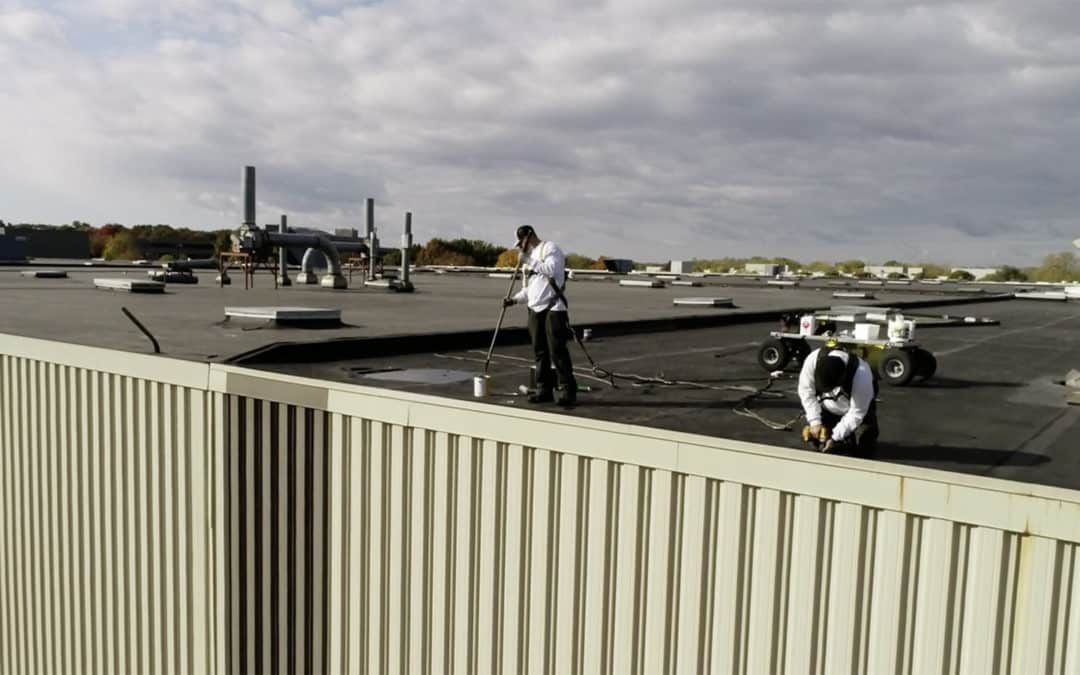Getting a commercial roof replaced is no small job. And if your business is faced with the reality of needing a new roof, you probably have several questions going through your mind. After all, it’s a big investment for any company.
However, understanding what you should expect from a professional commercial roofing company can help avoid any surprises during your replacement.
In this blog, we’ll walk you through the four steps involved in a complete replacement — from planning to installation.
4 Steps of a Commercial Roof Replacement
Step 1: Assessment and Planning
At Weather Shield Roofing Systems, we begin our re-roofing process with an in-depth inspection of your roof’s current condition. During the inspection, we use infrared and nuclear scanning technology to precisely diagnose any underlying issues or areas of concern.
With that, we also take a look at any areas of your roof that are in decent condition. Unlike other companies, we do everything we can to avoid doing a full roof replacement if we don’t have to. So, if we find that enough of your roof is able to be saved with minimal repairs, we’ll be sure to let you know. And if it can’t be repaired, we make it a priority to “recycle in place”. This means we take your dry/serviceable materials and reincorporate into the new roof — saving you money in the long run.
Once our inspection is complete, you’ll get a full report of our findings, along with our next steps and recommendations to get the job started.
Step 2: Preparation Stage
If a full re-roofing job is the best plan of action for your business, it’s time for the prep work. In this stage, we draw out a plan for your new roof and determine the materials needed. Your contractor will then handle all things surrounding local delivery, regulations, and site permits to make sure work can begin smoothly.
We’ll also answer any questions you may have before you begin. For example, one common question we get is “Will my employees and I still be able to work on-site while roofing work is happening?
The answer will depend on your business’s structure and the type of replacement happening. Some businesses will need to completely clear out, while others who are doing partial replacements might be able to continue operations in a specific section of the building.
Overall, your contractor will be there every step of the way to answer any questions that come up.
Step 3: The Roof Replacement Process
Now it’s time for the actual replacement to begin. To break things down, this happens in two stages. Stage one, removing your old roofing. Stage two, installation of your new materials. Here’s what to expect during each of the two stages.
Stage 1: Removal of the Old Roof
The first stage to replacing your industrial roof is to carefully remove the existing roofing material while avoiding any further damage to the building. This is done in a very specific process to minimize interruptions to your work, and keep those inside the building safe.
When removing the old roof, we do our best to recycle in place by extracting any salvageable materials and using it in your new roof. This not only helps you save money, but it also helps keep roofing materials out of the environment.
Stage 2: Installation of New Roof
Once your old roof is removed, it’s time for the fun part — installing your new industrial roof.
As one of the Top 100 Roofing Contractors in the U.S., we’ve been in business since 1980 — so you can trust that your commercial roof is in good hands.
Step 4: Inspection
Once the work is complete, a certified Weather Shield roofer completes a final inspection. The final inspection ensures that every detail meets the highest quality standards.
During this time, your contractor will also provide you with any necessary warranty information and provide you with information on setting up regular maintenance inspections for your commercial roof.
Ready to get started?
Want to learn more about commercial roof replacement? Visit our webpage for more information, or request an estimate if you’re interested in learning more about your roof’s condition.

